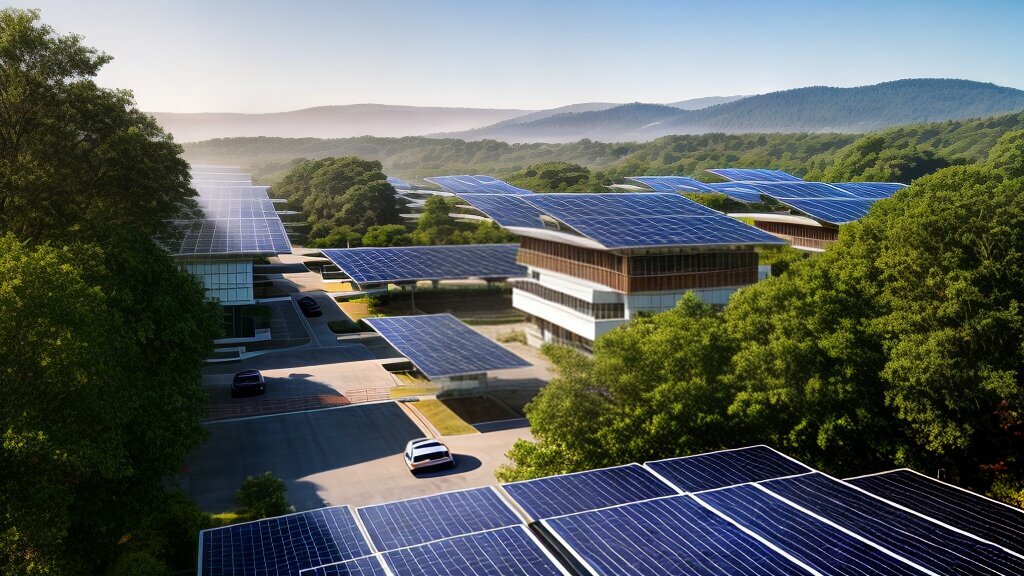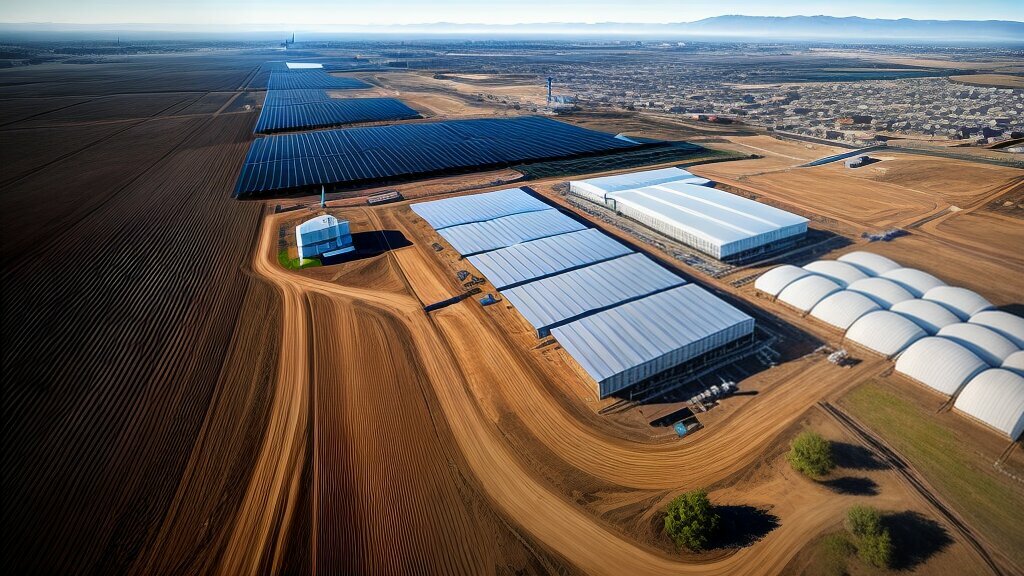Welcome to our upcoming article on renewable energy integration in large-scale construction projects. In a world where sustainability and efficiency are becoming increasingly important, it is essential that we explore new solutions to meet our energy demands. One of these solutions is the integration of renewable energy technologies into construction projects, which can bring significant benefits to both the environment and the economy.
Renewable energy integration involves the adoption of clean and green energy sources like solar, wind, and geothermal power within the existing energy infrastructure of construction projects. This integration can contribute to reducing carbon emissions, promoting sustainable energy practices and supporting the transition towards a more sustainable future.
Key Takeaways:
- Large-scale construction projects can benefit greatly from the integration of renewable energy technologies.
- Renewable energy is clean and green energy and differs from traditional energy sources.
- Integrating renewable energy into construction projects can help meet energy demands in a sustainable way.
Understanding Renewable Energy
Renewable energy, also known as clean or green energy, is energy that is generated from natural sources that are replenished over time. Unlike traditional energy sources like coal and oil, renewable energy does not produce harmful emissions that contribute to climate change and other environmental issues. Renewable energy is becoming increasingly important in the context of sustainable development and the transition towards a more sustainable energy future.
There are several types of renewable energy technologies, including:
| Type of Renewable Energy |
Description |
Benefits |
| Solar Power |
Energy harnessed from sunlight using photovoltaic panels |
Low to zero emissions, modular and scalable technology, abundant source of energy |
| Wind Energy |
Energy generated by wind turbines that convert the kinetic energy of wind into electrical power |
Low to zero emissions, cost-effective, reliable source of energy |
| Hydropower |
Energy generated from the kinetic energy of falling water that drives turbines to produce electricity |
Zero emissions, versatile technology with potential for large-scale production |
| Geothermal Systems |
Energy generated by harnessing heat from the Earth’s core to produce electricity or heat buildings |
Low to zero emissions, stable and reliable energy source, potential for long-term cost savings |
| Bioenergy |
Energy generated from organic matter like biomass or waste material |
Low to zero emissions, potential for local production and energy security, helps to reduce landfill waste |
These renewable energy technologies offer a range of benefits compared to traditional energy sources. They are abundant, versatile, and have the potential for long-term sustainability. Additionally, renewable energy can help to reduce greenhouse gas emissions, improve air quality, and support a more resilient and stable energy system.

Energy Integration in Construction
Energy integration is a crucial consideration in large-scale construction projects, with sustainability and cost efficiency being primary goals. The integration of renewable energy solutions plays a significant role in achieving these objectives.
However, it often presents challenges due to the existing energy infrastructure and traditional energy sources used in construction projects. Integrating renewable energy sources into this infrastructure requires careful planning and execution to ensure optimal results.
One of the key challenges of energy integration in construction is the intermittency of renewable power sources, such as solar and wind energy. This presents a challenge in terms of ensuring a consistent and reliable power supply throughout the construction project. Additionally, grid integration can also be a challenge, particularly when the existing infrastructure is not compatible with renewable energy sources.
Despite these challenges, the integration of renewable energy solutions into construction projects presents numerous opportunities. These include reducing greenhouse gas emissions, decreasing reliance on fossil fuels, and driving the transition towards a more sustainable energy future.

Benefits of Renewable Energy Integration
Renewable energy integration in large-scale construction projects brings numerous benefits that go beyond just reducing carbon emissions.
| Benefits |
Description |
| Sustainability |
The integration of renewable energy sources promotes sustainable energy practices and contributes to a greener future. |
| Long-term economic savings |
While the initial investment in renewable energy solutions may be high, the long-term economic savings are significant, particularly in terms of energy efficiency and reduced operational costs. |
| Improved public image |
Companies that prioritize sustainability and integrate renewable energy into their operations enjoy a positive public image, which can translate into improved brand reputation and customer loyalty. |
| Support for local communities |
Renewable energy integration creates job opportunities and supports local communities through investments in infrastructure and community development projects. |
By transitioning towards renewable energy solutions, large-scale construction projects can lead the way in the energy transition and pave the way for a cleaner and more sustainable future.

Renewable Energy Technologies for Construction Projects
There are various renewable energy technologies that can be incorporated into large-scale construction projects, offering sustainable and clean energy solutions.
Solar Power
Solar power is a popular and widely-used renewable energy technology. It involves the conversion of sunlight into electrical energy through the use of photovoltaic (PV) solar panels. The panels can be installed on rooftops, facades, and other suitable surfaces to generate electricity.
Solar power can be particularly effective in construction projects where electricity demand is highest during the day, such as in commercial buildings. Additionally, solar power can be combined with energy storage systems to provide electricity during periods of low sunlight, ensuring a continuous energy supply.
According to the International Energy Agency, solar energy is expected to be the largest source of electricity by 2030, making it an important technology for future construction projects.

Wind Energy
Another renewable energy technology that can be integrated into construction projects is wind energy. This involves the use of wind turbines to generate electricity from wind power. Wind turbines can be installed on rooftops, open spaces, or offshore, depending on the project’s requirements.
One of the advantages of wind energy is its scalability, with projects ranging from single turbines to large-scale wind farms. Additionally, wind energy can help reduce greenhouse gas emissions and provide an alternative source of energy in areas where traditional grids are unreliable.
Geothermal Systems
Geothermal systems involve the use of the earth’s natural heat to provide energy for heating and cooling. The technology involves the installation of a ground loop system that circulates water through underground pipes to absorb or release heat. The heat can be used to provide space heating, hot water, and air conditioning.
Geothermal systems can be particularly effective in construction projects that require a significant amount of energy for heating and cooling. This includes large office buildings, hospitals, and residential buildings. According to the United States Department of Energy, geothermal systems can reduce energy consumption by up to 70% compared to traditional heating and cooling systems.
Other Innovative Solutions
There are several other innovative renewable energy solutions that can be integrated into construction projects, including:
- Hydropower systems that harness the power of flowing water to generate electricity.
- Biomass systems that use organic matter, such as wood chips or agricultural waste, to generate heat and electricity.
- Tidal energy systems that generate electricity from the movement of tides in coastal areas.
- Wave energy systems that harness the energy of ocean waves to generate electricity.
Each of these technologies offers unique benefits and can be used in a variety of construction projects depending on the project’s requirements and location.
Overcoming Challenges in Renewable Energy Integration
While renewable energy integration offers many benefits for large-scale construction projects, there are also challenges that need to be addressed to ensure successful implementation.
One of the main challenges is scalability. Renewable energy sources such as solar and wind power are variable and depend on weather conditions, making it difficult to provide a consistent supply of power. As a result, large-scale renewable power plants may require significant investment in energy storage solutions to ensure a consistent supply of electricity.
Another challenge is grid integration. The existing energy infrastructure may not be designed to handle the intermittent nature of renewable energy sources, making it difficult to integrate them into the grid system. This requires significant investment in smart grid solutions that can manage the fluctuating supply of energy from renewable sources.
Intermittency is also an issue. Wind and solar power are dependent on weather conditions and therefore may not be able to provide power 24/7. This can lead to issues with energy demand during periods of low or no supply. For example, if there is not enough energy being created during peak hours, the energy infrastructure may not be able to keep up with the energy demand.
However, these challenges can be overcome with the right technology and investment. For example, energy storage solutions such as batteries can help store excess energy during periods of high supply, which can then be used during periods of low supply. Smart grid technology can also help manage the energy demand and supply by balancing the grid system in real-time.

Renewable energy integration offers many benefits, but it also comes with its own challenges that need to be addressed.
Case Studies of Successful Renewable Energy Integration
Real-life examples demonstrate the positive outcomes of renewable energy integration in large-scale construction projects. The following case studies showcase projects that have effectively incorporated renewable energy technologies to achieve their sustainability goals:
| Case Study |
Project Details |
Renewable Energy Solution |
Benefits |
| The Edge, Amsterdam |
A sustainable office building designed to produce more energy than it consumes. |
Solar panels, geothermal heating and cooling system, rainwater harvesting, LED lighting |
Reduced energy costs, zero carbon emissions, BREEAM certification, healthier work environment. |
| Burbo Bank Extension, Liverpool Bay |
An offshore wind farm that can power 230,000 homes. |
32 wind turbines with a combined capacity of 258 MW |
Reduced carbon emissions, renewable energy generation, job creation, community funding. |
| Hesperia Tower, Barcelona |
A luxury hotel that prioritizes sustainability and energy efficiency. |
Solar panels, waste-to-energy system, energy-efficient lighting and HVAC systems |
Reduced energy costs, zero waste generation, ISO 14001 and EMAS certification, enhanced guest experience. |
These case studies illustrate the potential of renewable energy integration in large-scale construction projects. By adopting innovative solutions, construction projects can reduce their environmental impact, increase their energy efficiency, and contribute to the transition towards a more sustainable energy future.

Policy and Regulatory Framework for Renewable Energy Integration
The success of renewable energy integration in large-scale construction projects is heavily dependent on supportive policies and regulations. Governments, industry stakeholders, and international agreements play a crucial role in driving the adoption of renewable energy solutions and promoting a sustainable energy future.
One of the key policy mechanisms for supporting renewable energy integration is feed-in tariffs (FITs). These are financial incentives provided to renewable energy generators, often in the form of guaranteed long-term contracts, to encourage investment in renewable power. FITs have been successful in driving renewable energy growth in many countries, including Germany, which has become a global leader in solar power generation.
Other policy mechanisms include renewable portfolio standards (RPSs), which require a certain percentage of energy to come from renewable sources, and net metering, which allows individuals or businesses to offset their electricity use with energy generated from their own renewable sources.
Industry standards and certifications can also play a role in promoting renewable energy integration. The Leadership in Energy and Environmental Design (LEED) certification, for example, encourages sustainability in building design and construction and provides recognition for buildings that incorporate renewable energy solutions.
| Policy Mechanism |
Description |
Examples |
| Feed-in tariffs (FITs) |
Financial incentives for renewable energy generators, usually in the form of guaranteed contracts |
Germany, France, Spain |
| Renewable portfolio standards (RPSs) |
Requirements for a certain percentage of energy to come from renewable sources |
California, Colorado, Hawaii |
| Net metering |
Allows individuals or businesses to offset electricity use with energy generated from their own renewable sources |
California, New York, Texas |
International agreements can also play a role in promoting renewable energy integration. The Paris Agreement, for example, is a global commitment to reducing greenhouse gas emissions and promoting sustainable development. It provides a framework for countries to set targets for reducing emissions and transitioning to a low-carbon economy.
Overall, a supportive policy and regulatory framework is essential for driving the adoption of renewable energy solutions in large-scale construction projects. By providing financial incentives, setting targets, and promoting sustainability, governments and industry stakeholders can work together to drive the transition towards a more sustainable energy future.

Future Trends in Renewable Energy Integration
As technology continues to advance, the future of renewable energy integration in large-scale construction projects is looking promising. One of the most significant advancements in this field is the development of energy storage solutions.
Energy storage allows excess energy generated from renewable sources such as solar or wind to be stored and used when needed, eliminating the issue of intermittency. This development paves the way for larger scale renewable power generation and more reliable energy supply for construction projects.
Another emerging trend is the use of smart grids in construction projects. Smart grids enable the integration of various energy sources and the management of energy flow in real-time, optimizing the energy use and reducing waste.
In addition to energy storage and smart grid systems, there are also several other innovative renewable energy solutions on the horizon. For example, researchers are exploring the potential of wave energy, which harnesses the power of ocean waves to generate electricity.
The use of renewable energy in construction projects is also becoming more efficient, thanks to advancements in construction materials and techniques. For instance, construction companies are experimenting with building-integrated photovoltaics, which incorporates solar panels into building facades and roofs, reducing the need for additional space and infrastructure.

Overall, the future of renewable energy integration in construction looks bright. With the continued development of new technologies and the increasing demand for sustainable energy solutions, we can expect to see more large-scale construction projects incorporating renewable energy in the coming years.
Financial Considerations and Return on Investment
Despite the many benefits of renewable energy integration in large-scale construction projects, one of the biggest concerns for project owners and developers is cost. However, with advancements in technology and government incentives, renewable energy solutions are becoming increasingly cost-effective and financially viable.
One of the main advantages of incorporating renewable energy sources is the potential for long-term cost savings. While the initial investment may be higher than traditional energy sources, renewable energy solutions have lower operational and maintenance costs, resulting in significant savings over time.
Additionally, many governments offer financial incentives and subsidies for renewable energy projects, further reducing the overall cost. For example, in the UK, businesses can benefit from the Renewable Heat Incentive (RHI) and the Feed-in Tariffs (FITs) scheme, which provides financial support for renewable energy technologies.
The return on investment for renewable energy integration is also significant. Besides the cost savings, incorporating sustainable energy solutions can enhance a project’s reputation and increase its value. Consumers and stakeholders are increasingly prioritizing sustainability, and incorporating renewable energy solutions can demonstrate a commitment to environmental responsibility and attract more customers.
| Type of Renewable Energy Solution |
Cost Savings |
Return on Investment |
| Solar Power |
Up to 70% lifetime cost savings compared to conventional energy sources |
4-5 years |
| Wind Energy |
Up to 50% lifetime cost savings compared to conventional energy sources |
5-8 years |
| Biomass Energy |
Up to 40% lifetime cost savings compared to conventional energy sources |
3-5 years |
Source: Center for Climate and Energy Solutions

The financial considerations and return on investment associated with renewable energy integration in large-scale construction projects make it an attractive option for project owners and developers. By embracing sustainable energy solutions, industry stakeholders can not only reduce costs and enhance their reputation but also contribute to a more sustainable future.
Environmental and Social Impact of Renewable Energy Integration
The adoption of renewable energy solutions in large-scale construction projects has a positive impact on our environment and society. Renewable energy integration reduces carbon emissions and helps mitigate the effects of climate change through the reduction of greenhouse gas emissions.
Furthermore, renewable energy integration in construction projects has the potential to improve air quality, reduce levels of noise pollution, and limit carbon output in urban areas. These sustainable energy solutions can help transform our cities into cleaner and healthier places to live and work, with fewer negative impacts on human health and the environment.
The social impact of renewable energy integration in large-scale construction projects is also significant. The construction and maintenance of renewable energy infrastructure creates green jobs, providing opportunities for local communities. Moreover, renewable energy infrastructure can be integrated into community development projects, promoting sustainable living and supporting local energy access.
The adoption of renewable energy integration in construction projects is essential to reducing our environmental impact and ensuring a sustainable future. By embracing renewable energy solutions, we can create healthier, more liveable communities and promote a more sustainable future for generations to come.

Conclusion
In conclusion, renewable energy integration in large-scale construction projects is crucial for achieving sustainability goals and driving the transition towards a more sustainable energy future. The benefits of incorporating renewable energy solutions are manifold, ranging from reducing greenhouse gas emissions, improving air quality, creating green jobs, and supporting local communities.
However, there are also challenges and obstacles to overcome, such as scalability, intermittency, and grid integration. Fortunately, there are potential solutions and emerging technologies that can help overcome these challenges and further enhance the integration of renewable energy sources.
Policy and regulatory frameworks also play a critical role in promoting renewable energy integration in the construction industry. Governments and industry stakeholders need to adopt supportive policies and regulations that incentivize the adoption of renewable energy solutions and facilitate their integration into existing energy infrastructure.
Finally, financial considerations and return on investment are also significant factors to consider in the adoption of renewable energy solutions. The potential cost-saving benefits, government incentives, and long-term economic viability of incorporating renewable energy solutions make it a smart choice for construction projects.
Overall, it is time for the construction industry to embrace renewable energy integration and make a significant contribution to a more sustainable and greener future.
FAQ
Q: What is renewable energy integration in large-scale construction projects?
A: Renewable energy integration refers to the incorporation of renewable energy solutions, such as solar power and wind energy, into the energy infrastructure of large-scale construction projects. It aims to reduce reliance on traditional energy sources, promote sustainability, and improve overall energy efficiency.
Q: Why is renewable energy integration important?
A: Renewable energy integration is important because it allows construction projects to contribute to sustainability goals and reduce greenhouse gas emissions. It also helps drive the transition towards a more sustainable energy future by utilizing clean and renewable sources of energy.
Q: What are the benefits of renewable energy integration?
A: The benefits of renewable energy integration in large-scale construction projects include reduced carbon emissions, improved energy efficiency, cost savings, and long-term economic viability. It also creates opportunities for job creation and supports local communities.
Q: What types of renewable energy technologies can be integrated into construction projects?
A: Construction projects can integrate various renewable energy technologies, including solar power systems, wind turbines, geothermal systems, and other innovative solutions. These technologies help meet the energy demands of the projects in a sustainable and environmentally friendly manner.
Q: What are the challenges in renewable energy integration?
A: Some of the challenges in renewable energy integration include issues of scalability, intermittency of renewable power sources, and grid integration. However, there are potential solutions and advancements in technology that can help overcome these challenges.
Q: Can you provide examples of successful renewable energy integration in construction projects?
A: Yes, there are several real-life examples of successful renewable energy integration in large-scale construction projects. These projects have effectively incorporated renewable energy technologies and have achieved positive outcomes in terms of sustainability and energy efficiency.
Q: What is the policy and regulatory framework for renewable energy integration?
A: The policy and regulatory framework for renewable energy integration involves supportive policies and regulations that promote the adoption of renewable energy solutions in construction projects. Governments, industry stakeholders, and international agreements play a crucial role in driving the transition towards sustainable energy.
Q: What are the future trends in renewable energy integration?
A: The future trends in renewable energy integration for large-scale construction projects include advancements in energy storage, smart grid systems, and other innovative technologies. These developments aim to further enhance the integration of renewable energy sources and improve overall energy efficiency.
Q: What are the financial considerations and return on investment for renewable energy integration?
A: Financial considerations for renewable energy integration include the initial investment costs, potential cost savings, and government incentives. The return on investment can be achieved through reduced energy costs, long-term economic viability, and improved sustainability credentials for construction projects.
Q: What is the environmental and social impact of renewable energy integration?
A: Renewable energy integration has a positive environmental impact as it reduces carbon emissions, improves air quality, and promotes sustainability. It also has a social impact by creating green jobs and supporting local communities.




























Post comments (1)